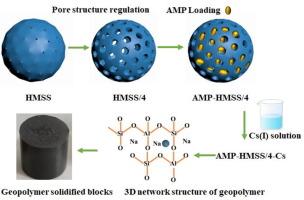硅基磷钼酸铵和地聚合物对Cs+的高效去除和稳定固定化
IF 13.2
1区 工程技术
Q1 ENGINEERING, CHEMICAL
引用次数: 0
摘要
137Cs是放射性废水中主要的生热核素,半衰期长,放射性强,毒性大。因此,放射性废水中Cs+的吸附-固定化对人类健康和环境安全至关重要。本研究首先通过使用不同量的扩孔剂来调整中空介孔硅球(HMSS)的孔隙结构,然后将磷钼酸铵(AMP)负载在HMSS上,制备了一种新型的铯吸附剂(AMP-HMSS)。AMP- hmss利用介孔中空结构和AMP负载,对Cs+表现出优异的吸附能力,最大吸附量为179.21 mg/g,具有较高的吸附选择性。AMP-HMSS在强酸性溶液(高达1 mol/L HCl)中的吸附性能明显优于HMSS。AMP-HMSS对Cs+的主要去除机制是Cs+与NH4+的交换以及羟基的参与。将废吸附剂(AMP-HMSS/4-Cs)固定在粉煤灰基地聚合物中。即使在含盐环境下,该聚合物也表现出良好的抗浸出性能,表明Cs+可以稳定地固定在该聚合物中。900℃煅烧8 h后,地聚合物中生成了新相的沸石和霞石,其抗压强度随之提高。本文章由计算机程序翻译,如有差异,请以英文原文为准。

Efficient removal and stable immobilization of Cs+ by silica-based ammonium phosphomolybdate and geopolymer
137Cs, as the main heat-generating nuclide in radioactive wastewater, has a long half-life, strong radioactivity and toxicity. Thus, Cs+ adsorption–immobilization from radioactive wastewater is essential for human health and environmental safety. In this study, the pore structure of hollow mesoporous silica spheres (HMSS) was firstly adjusted by the use different amount of pore-expanding agents, and then ammonium phosphomolybdate (AMP) was loaded onto HMSS to prepare a novel adsorbent (AMP-HMSS) for cesium. Taking advantage of the mesoporous and hollow structure and AMP loading, AMP-HMSS showed outstanding adsorption ability for Cs+ with maximum adsorption capacity of 179.21 mg/g and high adsorption selectivity. AMP-HMSS showed much better adsorption performance than HMSS in the strong acidic solution (up to 1 mol/L HCl). The governing removal mechanism of AMP-HMSS for Cs+ was exchange between Cs+ and NH4+ along with participation of hydroxyl group. Moreover, spent adsorbents (AMP-HMSS/4-Cs) was immobilized in fly ash-based geopolymer. The geopolymer displayed good anti-leaching performance even in the salty environment, which indicated that Cs+ could be stably immobilized in the geopolymer. After calcination of 900 ℃ for 8 h, new phases zeolite and nepheline was generated in the geopolymer and subsequently enhanced its compressive strength.
求助全文
通过发布文献求助,成功后即可免费获取论文全文。
去求助
来源期刊

Chemical Engineering Journal
工程技术-工程:化工
CiteScore
21.70
自引率
9.30%
发文量
6781
审稿时长
2.4 months
期刊介绍:
The Chemical Engineering Journal is an international research journal that invites contributions of original and novel fundamental research. It aims to provide an international platform for presenting original fundamental research, interpretative reviews, and discussions on new developments in chemical engineering. The journal welcomes papers that describe novel theory and its practical application, as well as those that demonstrate the transfer of techniques from other disciplines. It also welcomes reports on carefully conducted experimental work that is soundly interpreted. The main focus of the journal is on original and rigorous research results that have broad significance. The Catalysis section within the Chemical Engineering Journal focuses specifically on Experimental and Theoretical studies in the fields of heterogeneous catalysis, molecular catalysis, and biocatalysis. These studies have industrial impact on various sectors such as chemicals, energy, materials, foods, healthcare, and environmental protection.
 求助内容:
求助内容: 应助结果提醒方式:
应助结果提醒方式:


